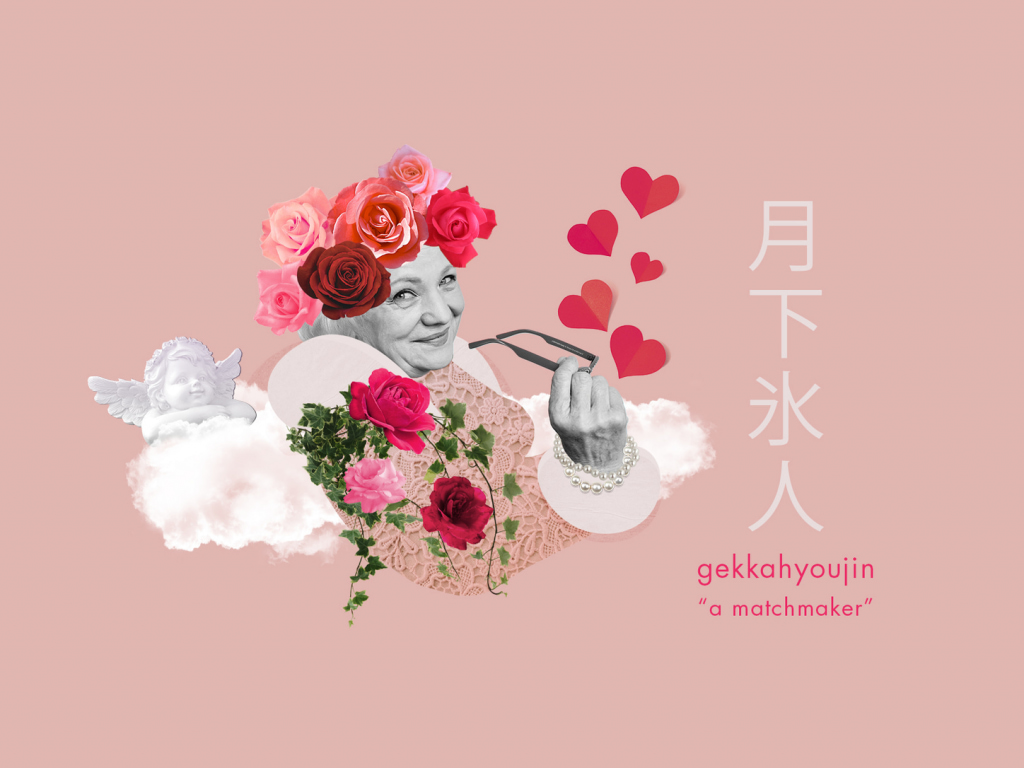As we turn our gazes to the sky for the year’s Tsukimi celebration, we celebrate the harvest moon and Tsukimi with a lunar-insured yojijukugo: gekkahyoujin. You may have come across it on gaming websites or even at weddings.
Gekkahyoujin (月下氷人)
Meaning: A matchmaker, go-between, marriage broker, someone who plays Cupid
Literal translation and kanji breakdown: By separating 月下氷人 into two separate compounds, we get “under the moon” (月下 gekka) and “ice person” (氷人 hyoujin). While this doesn’t make much sense, it helps to know that gekkahyoujin is a mix of two different compounds: 月下老人 (gekkaroujin) and 氷上人(hyoujyojin), which mean an old man under the moon and a person over the ice, respectively. The former refers to Yue Lao, a divine matchmaker who ties people together with the red string of fate before they are even born. To learn more about Yue Lao, as well as who the person on the ice is, read the origin stories below.
Note: Many native Japanese speakers confuse gekkahyoujin with gekkabijin (月下美人), which means a beauty under the moonlight. It’s the name of a night-blooming cereus.
Gekkahyoujin: The Origins
Gekkahyoujin is a combination of two different kanji compounds — and two separate legends.
Gekkaroujin 月下老人
Gekkaroujin originates from a Tang Dynasty (618-907) tale about Yue Lao, a divine matchmaker. There are many different versions of the story but here is a short and sweet one.
A young man named Wei Gu was desperate to be married. One night, while on a walk, he met an older gentleman reading some calligraphy under a moonlit sky. They chatted for a bit and Wei Gu mentioned he has plans to marry the daughter of a top official. He would be meeting her the following day. The old man shook his head and said that it wasn’t meant to be and that Wei Gu’s true match was still only three years old. He would not marry for another 14 years. Wei Gu was shocked and asked to see his supposed bride-to-be. Yue Lao acquiesced, showing him an old woman in rags holding a small, dirty child in her arms. Wei Gu was not impressed. Yue Lao warned him that the red thread of fate was already tied and there was nothing he could do to choose his future, but Wei Gu was not convinced. He ordered a servant to kill the girl to prevent this obvious mismatch.
The servant set out to follow his master’s orders but only managed to injure her, making a deep cut in her forehead. Years passed and Wei Gu stayed single. He joined the army and was eventually recognized by Governor Wang, who offered his 17-year-old daughter as a bride. Wei Gu accepted — she was beautiful, rich and kind. They wed, but he soon noticed she covered her forehead with floral decorations. When he asked her about it, she told him she was attacked by a child when in her nursemaid’s care. Her parents died some years later and Governor Wang adopted her as his own some time after that. Wei Gu confessed to his heinous crime and his wife was magnanimous enough to forgive him. We presume they lived happily ever after. The moral of the story? We cannot escape our fate.
Hyoujojin 氷上人
As for the second part of gekkahyoujin’s kanji compound, this story originates from the Book of Jin, a historic record of the Jin Dynasty (266-420).
A man named Reiko Saku approached Sakutan, a famous fortuneteller, about a dream he had the night before. He was standing on the ice, speaking to someone beneath it. Sakutan explained that the ice in yang, and whatever is under the ice is yin. He said that Reiko Saku was working as an intermediary between the contrary forces and it meant he was destined to be a matchmaker. Sakutan was right — Reiko Saku later became a gifted marriage broker, making good matches across the region.
Gekkahyoujin: Similar Expressions
- 赤い糸で結ばれる Akai ito de musubareru To be tied together by the red string of fate; be meant for each other, to be destined to be together, a match made in heaven.
- 運命の赤い糸 Unmei no akai ito The red string of fate
- 袖振り合うも多生の縁 Sode furiau mo tashou no en Even the smallest incident is no accident, a meeting by chance is preordained, so cherish every encounter
- 運は天にあり Un wa ten ni ari Fate is decided by the gods; there’s no escaping fate
- 人事を尽くして天命を待つ Jinji wo tsukushite, tenmei wo matsu People do what they can, then wait for the verdict of the gods; man proposes, God disposes
Using “gekkahyoujin” in a sentence
The role of the gekkahyoujin has evolved over the years and is often referred to someone assisting in wedding preparations or making a speech — even bridesmaids can take on this role. For actual Cupid-like interventions, the gekkahyoujin is often a serendipitous or unwitting catalyst for a romance between two others. For more calculating matchmaking, 仲人 (nakoudo) and 媒酌人 baishakunin are more typical.
夢で結婚する相手を見た。どっかで月下氷人がいるのかもね。Yume de kekkon suru aite wo mita. Dokka de gekkahyoujin ga iru no kamo ne. I saw my future partner in a dream. I guess there’s a Cupid out there somewhere.
親の月下氷人はセラピストだった。 二人がそこに通っていたことが知り合うきっかけになった。Oya no gekkahyoujin wa serapisuto datta. Futari ga soko ni kayotteita koto ga shiriau kikkake ni natta. My parents’ unwitting matchmaker was a therapist. They both went to the same one and that’s how they met.
Want more? Follow our weekly Yojijukugo Japanese Idiom series, published every Friday. Learn the meaning of “chinpunkanpun” here, “yudantaiteki” here, “furouchouju” here and “kachoufugetsu” here.









